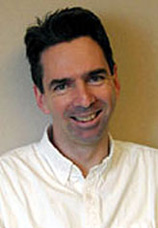 When Wallace Thoreson, Ph.D., was in college, his textbooks seemed to indicate that scientists had perfect vision on almost everything about human eyesight.
When Wallace Thoreson, Ph.D., was in college, his textbooks seemed to indicate that scientists had perfect vision on almost everything about human eyesight.
However, as he progressed through his graduate and post-graduate training, Dr. Thoreson realized that the science world’s focus of vision function and disease was more than a little blurry.
“As you study it more, instead of understanding everything and filling in all of the gaps, you see all of the gaps,” said Dr. Thoreson, an associate professor in the departments of ophthalmology and pharmacology at UNMC, and in the department of biology at the University of Nebraska at Omaha. “That’s what makes it exciting. There are major gaps in our knowledge, and we’re working to find answers to some of those gaps.”
For his work in eye research, specifically his research investigation into synaptic transmission from rods and cones, Dr. Thoreson is being honored as the recipient of the 2003 College of Medicine Joseph P. Gilmore Outstanding Investigator Award.
Leading the field
Carl Camras, M.D., chairman of the department of ophthalmology, said Dr. Thoreson’s exemplary scientific work is leading to his recognition as one of the world’s outstanding retinal physiologists.
|
Dr. Gilmore was professor and chairman of the department of physiology from 1970 to 1987. He was funded by the National Institutes of Health for his entire career, supervised numerous graduate students and post-doctoral fellows, and published more than 200 scientific papers. The Joseph P. Gilmore Award was established by the department of physiology and biophysics upon Dr. Gilmore’s retirement in 1987 to recognize outstanding research contributions by a faculty member. |
“Dr. Thoreson’s innovative research on basic mechanisms of visual processing within the retina supplies us with important new information, which helps us to better understand vision in health and in disease,” Dr. Camras said. “In addition to his important contributions to research, he provides our department with valued administrative skills. He is a wonderful person who is so very deserving of this prestigious award.”
How human vision works
To increase the basic knowledge of how human vision works, Dr. Thoreson studies early steps in the processing of visual information by the retina, a tissue that lines the inside of the eye. His research has been funded by the National Institutes of Health since he came to UNMC a decade ago.
“We need a better fundamental understanding of how this works normally, so that we can better understand what goes wrong in eye disease, and ultimately how we can treat people better who have specific eye diseases,” Dr. Thoreson said.
Acting much like the film in a camera, the retina contains light-receiving cells called rods and cones, which are photoreceptors. The rods and cones gather incoming light and send the impulses to the brain through the optic nerve.
Dr. Thoreson’s studies
Dr. Thoreson studies release of the neurotransmitter glutamate by the rods and cones, and how this release is modulated, or regulated, by specific naturally occurring substances such as dopamine, adenosine, insulin, chloride ions and calcium ions.
“Calcium channels and glutamate receptors play essential roles in the synaptic transmission from rods and cones, but over-stimulation of these things can promote nerve cell damage,” he said.
That nerve cell damage is found in many eye diseases, such as glaucoma, stroke, ischemia and perhaps macular degeneration, Dr. Thoreson said.
Dr. Thoreson’s lab is the only one in the world to have recorded single calcium channels from photoreceptors. He has recently developed techniques that allow him to measure calcium entry into photoreceptor terminals while simultaneously measuring the release of synaptic vesicles, which are small organelles that contain neurotransmitter molecules. These technically challenging experiments have revealed an unusually high sensitivity to calcium that allows rod photoreceptors to relay information about small changes in illumination with high fidelity.
“We’re excited about the new findings because of what they tell us about how we see the world and because of what they suggest about how neurotransmitters might be released at other synapses in the central nervous system,” he said.
Collaborations here, abroad
In addition to this research, Dr. Thoreson has worked with other UNMC investigators on several collaborative projects, including how too much cell proliferation can damage the eye; how growth factors affect eye disease; and the physiological characteristics of ocular stem cells that have become different types of nerve cells.
“They actually look like nerve cells before they act like them,” Dr. Thoreson said of the cells, which are being studied by Iqbal Ahmad, M.D. an associate professor of ophthalmology and pharmacology.
Dr. Thoreson also has active collaborations with researchers in New Jersey, at the University of Texas, University of Minnesota, New York University, and in Italy.
“I have a lot of collaborative projects with people elsewhere,” Dr. Thoreson said. “It’s so easy to transfer data with all of the current technology. These collaborations increase the effective size of my lab and my projects.”